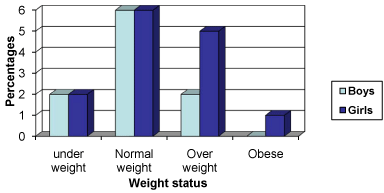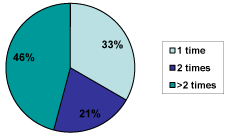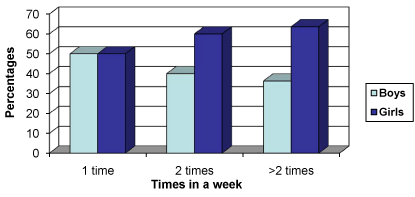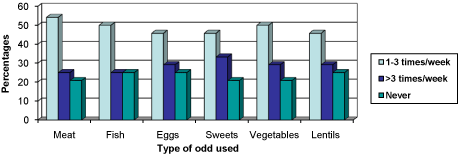Research Article Open Access
Assessment of Cardiovascular Disease Risk Factors among School Children in Private Schools in Karachi, Pakistan: A Pilot Study
| Alia Nasir1*and Hakim Shah2 | |
| 1Head, Aman Community Health Programme, Aman Foundation, Karachi, Pakistan | |
| 2Assistant Professor, Institute of Nursing, Dow University of Health Sciences, Karachi, Pakistan | |
| Corresponding Author : | Ms. Alia Nasir, RN, RM, BscN, MA.EHPID (UK) Head, Aman Community Health Programme Aman Foundation, Karachi, Pakistan E-mail: alia.nasir@amanfoundation.org |
| Received June 20, 2012; Accepted August 04, 2012; Published August 09, 2012 | |
| Citation: Nasir A, Shah H (2012) Assessment of Cardiovascular Disease Risk Factors among School Children in Private Schools in Karachi, Pakistan: A Pilot Study. J Obes Wt Loss Ther 2:144 doi:10.4172/2165-7904.1000144 | |
| Copyright: © 2012 Nasir A, et al. This is an open-access article distributed under the terms of the Creative Commons Attribution License, which permits unrestricted use, distribution, and reproduction in any medium, provided the original author and source are credited. | |
Visit for more related articles at Journal of Obesity & Weight Loss Therapy
Abstract
The prevalence of cardiovascular diseases is increasing in Pakistan due to unhealthy life style, and lack of awareness. As these diseases have their origin in the early period of life therefore, the prevention of these diseases in early stage is necessary to prevent and control them. This study aimed at identifying the children at higher risk for developing CVDs at their later ages, and providing more focused interventions for them. A cross sectional pilot study was conducted at a private school in Karachi, Pakistan. A total of 24 students (10 boys, 14 girls) were selected through a systematic random sampling. Data was collected through a structured questionnaire. Their height and weight were taken to calculate BMI. Majority of the study participants (66.7 and 62.5%) reported that CVDs were the leading cause of death among the adults in Pakistan, while 25% were not aware. Only 29.2% agreed that CVDs were preventable diseases. They had poor knowledge regarding the prevention of CVDs, 50 % reported only exercise as being a preventive measure of CVDs. The mean time spent on doing home work was 19.46 hours/week, and doing sedentary recreational activity was 15.80 hours/week for both genders. Boys were more active, and they showed less tendency of obesity/overweight as compared to girls. The findings of this study highlight a significant lack of knowledge of modifiable risk factors among the study participants. The results suggest a need of planning health promotion program through schools by focusing on children and their parents in a participatory approach.
| Keywords |
| Cardiovascular diseases; School Health Promotion Program; Body Mass Index |
| Abbreviations |
| BMI: Body Mass Index; CDC: Center for Disease Control; CtC: Child-to-Child; CVD: Cardiovascular diseases; NCD: Non-communicable diseases; SHPP: School Health Promotion Program |
| Introduction |
| The burden of Non-Communicable Diseases [NCDs] is emerging as a major public health challenge for the developing countries. World Health Organization [WHO] estimates that NCDs account for 63% of mortality globally out of which around 80% of all deaths in low-income and developing countries [1]. These diseases are projected to increase 15% by the year 2010-2020 [1]. |
| Most common NCDs are cardiovascular diseases [CVDs], hypertension, and diabetes mellitus. Unhealthy lifestyle, which includes unhealthy dietary habits, physical inactivity, and smoking, is largely attributed to these diseases [2] apart from family history, age and gender. Studies reveal that CVDs account for a major cause of death globally [3,4]. The Prevalence of CVDs is increasing significantly in developing countries; unfortunately, there is a lack of awareness about the preventive measures of controlling, and reducing its expansion in these countries [4]. Furthermore, developing countries are facing the challenge of a demographic transition. On one hand, many of these countries are still unable to manage communicable diseases; on the other hand, their health system is not prepared to provide care to NCDs. According to report of United Nation International Fund for Children and Education [UNICEF], Pakistan is a developing country with poor health and socio-economic indicators, which cannot afford the emergence of this costly epidemic of NCDs to manage [5]. |
| According to a study, during the year 1990 in the Middle Eastern crescent region including Pakistan, CVDs were responsible for nearly 11% of Disability Adjusted Life Years [DALYs], and this was second only to infectious and parasitic diseases [6]. Moreover, South Asians are at a greater risk of developing CVDs at younger ages with more severity, and it is likely that escalation of the global CVDs epidemic will be most marked in Pakistan and India. One in four middle-aged adults in Pakistan has coronary artery disease (24% in men and 30% in women) [7]. Literature has revealed that less physical activity and unhealthy dietary habits are strongly associated with CVDs. Approximately, 58% of children had at least one of the modifiable risk factors for CVDs, such as obesity, physical inactivity and unhealthy dietary habits [8]. It is observed that children are adopting unhealthy lifestyles. There is an increased trend of indoor games and entertainment including watching TV, and playing computer and video games among the children [9,10]. In addition, there is an increased tendency of eating junk and dense caloric foods. Several studies reveal that many health problems, such as CVDs appear to originate from the childhood [11-13]. Pathological change, which results in CVDs, such as atherosclerosis begins in early childhood but it manifests itself clinically in adulthood [13]. |
| Obesity is one of the major modifiable causes for atherosclerosis development. The unhealthy dietary habits and lack of physical activity contribute to obesity. Therefore, it is recommended that this condition could be better tackled at an early age to avert the development of atherosclerosis, and reduce the risk of CVDs in adult life [14]. It is important to identify the unhealthy lifestyle and behaviors early to promote healthy changes during childhood and the adolescence period, as there is evidence that behavior once established in childhood is difficult to change in adulthood [15]. The available evidences suggests that a few studies are planned, and there is scarce data available regarding obesity, lack of exercise and unhealthy dietary habits among school children in Pakistan. Hence, there is nothing to prove the existence of any lifestyle problems relating to these areas in Pakistan. Through further research a more detailed analysis and explanation would be necessary to tackle this health problem in Pakistan. Health related behavioral data is regarded by the researcher as being valuable for future reference. It is expected that findings of this pilot study will raise new research questions and will point to a deeper and more qualitative and qualitative investigation on a larger scale. |
| The purpose of this pilot study is to explore the knowledge gap between CVDs and their risk factors, and to develop implementations to make up this gap in order to promote health, and thwart the risk factors of CVDs among School children in Karachi, Pakistan. The findings of this pilot study can be used as an indicator for determining the risk factors of CVDs in early childhood, and will serve as a baseline data for the next steps of research. This study, probably, can contribute to the existing pool of research related to preliminary risk factors of CVDs among school children in Karachi, Pakistan. The findings of this study can be used as a source to provide a basis for enhancing and expanding the research work on CVDS among children to prevent CVDs in their later ages. |
| Materials and Methods |
| Study procedures and participants |
| A cross sectional pilot study was conducted at a private school in urban area of Karachi, Pakistan. This school was selected because the management and researcher were planning to initiate a School Health Promotion Program [SHPP] focusing on CVD risk factors in future in the schools of same network. The study subjects were school children (both girls and boys) of class 10 who had consented to participate in the study. |
| The selection of the sample for this pilot study was a random sampling method [16]. Twenty four students were recruited for data collection. There were 40 boys and 55 girls, in separate classes of class 10. A total of 10 students from the boys and 14 from the girls sector were selected on a systematic random sampling method. Using their roll call register, every fourth student was selected for the sample of study. The first number was randomly selected by putting the finger by closing eyes. |
| Measures |
| Data was collected through a structured questionnaire (Appendix 1). This questionnaire was developed by the researcher after an extensive literature review on this topic, and then it was pilot tested. The major variables included in the questionnaire were: (a) demographic data, (b) knowledge variables, (c) non-modifiable risk factors, and (d) modifiable risk factors. Moreover, BMI was calculated by using Center for Disease Control (CDC) charts for both girls and boys separately [17]. Following CDC web based calculator used to calculate the study participant’s BMI based on their height, weight and demographic information [18]. The formula used for web-based calculation was taken from Source: Online Available. |
| http://www.cdc.gov/healthyweight/assessing/bmi/childrens_bmi/ about_childrens_bmi.html (accessed 15 March 2007). The cutoff point to detect under weight, norm al weight, over weight and obesity were drawn [18]. |
| Data was collected by the Community Health Volunteers (nurses), who were trained for this task by the researcher through a teleconference (as the researcher was in London and the interviewers were in Pakistan). |
| Questionnaires were circulated among all the selected participants. Once they completed the questionnaire, their height and weight were taken by the interviewers to calculate BMI. Their height was measured to the nearest 0.1 centimeter. In the beginning, measuring tapes with a centimeter scale were taped on a wall of the room. Then the study participants were asked to take off their shoes and stand erect with their back to the wall. Their weight was also measured to the nearest 0.1 kilogram. A bathroom scale was used for taking the weight. Study participants were asked to take off their shoes, extra clothes and to empty their pockets and (dupatta for girls). For every participant, first the scale was placed on the plain floor and was assured that the scale was on 0.1 kilogram, and then the participant was asked to stand erect on the scale. Data collectors noted down the actual weight in kilograms from the front and from the centre. Data collectors noted the height and weight in the relevant questionnaire. |
| The errors in the data were reduced at different stages by using quality assurance. Errors of non-observation were controlled by proper sampling technique, which have been discussed earlier. While errors of observation were controlled by; (a) Developing an appropriate questionnaire by pre-testing and pilot-testing of the instrument, (b) translating and back translating of the questionnaire in the local language (Urdu), and (c) training the interviewers. |
| Statistical Package for Social Sciences (SPSS) version 14 was used to analyze the data. Proportions of all variables of interest were calculated. |
| Ethical considerations |
| The proposal was sent to the school administration for their approval after a telephonic conversation with the head teacher. Prior to the interview, all participants signed on the consent form (Appendix 2). Anonymity of the individuals and institution was maintained during data analysis and findings. No invasive method and/ or technique was used, hence no harm to the study participants. |
| Results |
| The mean ages of the participants were 14.7 years. Table 1 shows the distribution of the socio-demographic characteristics of the study subjects. The majority of the study participants (66.7 and 62.5 per cent) stated that heart disease was the major health problem and was the leading cause of death among adults in Pakistan. While 25 per cent were not aware about the issue. Only 29.2 per cent agreed that CVD were preventable diseases (Figure 1). There was no difference in the knowledge about CVD among the boys and the girls |
| A majority of the study subjects were not aware about the other leading causes of CVD (Table 2). This table also shows a marked difference in the knowledge among boys and girls. Comparatively, boys seem to be more aware than the girls. |
| Generally, there is poor knowledge regarding what to do to prevent heart diseases, except exercise i.e. 50 per cent (Table 3). There is no significant gender difference in the knowledge of the participants. |
| The prevalence of CVD risk factors among the study participants has been presented in Table 4 and Table 5 and Figure 2 to Figure 4. Table 5 shows the BMI of the study population. There was no significant difference in the boys and girls regarding under-weight and normal weight. However, girls were remarkably more overweight/obese as compared to the boys (Figure 2). Other risk behaviours of developing CVD among the study population are presented in Table 5. There was no significant difference in the family history of CVD in both genders; however, boys were more active than girls in terms of physical activity and life style (Table 5). The mean time spent on doing home work in a week was 19.46 hours, and sedentary recreational activities 15.80 hours/week for both genders. |
| The following pie charts and bar chart in figures 3-5 represent the prevalence of risk factors related to nutrition among the study participants. |
| Choice of food selection is influenced by friends (62.5 percent), family (75 percent) and taste (66.7 percent). |
| Discussion and Implications of the Study |
| There is limited data available in this area of research in Pakistan which can help to assess the situation. This school based survey in an urban private school of Karachi, Pakistan has presented an estimation of knowledge regarding CVD risk factors and behaviour variables. These variables include obesity, physical inactivity, unhealthy dietary habits and positive family history of cardiac diseases. It forms the basis for future interventional projects both at school and community levels using a “whole school approach to health promotion”. |
| The results of the study suggest that there is a lack of awareness about the causes, preventive methods and risks factors (Table 3 and Table 4) A study shows a similar lack of awareness among school age children in the Hispanic population of North America, India and Pakistan respectively [19,20]. A lack of awareness regarding risk factors may impede taking preventive measures, as well as making positive lifestyle changes. This shows that boys are more aware about exercise than girls, both regarding the causes of heart diseases and their preventive strategies. |
| This study has reported higher prevalence of obesity (33.2 per cent) (Table 5) as compared to other local studies [8]. There could be several reasons of obesity in this pilot study. The reason could be the inactive lifestyle of girls as compared to boys (Table 5). |
| Moreover, literature reveals that childhood obesity is an epidemic problem throughout the world [21]. These trends are of particular importance because being an overweight in childhood and in young adults has been associated with an increased risk of hypertension, high cholesterol level, diabetes and early atherosclerosis [22]. |
| There is a marked difference in the knowledge about heart disease and prevalence of obesity among boys and girls. Boys have more knowledge, and are less obese whereas girls have less knowledge and are more obese. This may indicate that knowledge can contribute to prevent the obesity, however, it is difficult to conclude; therefore further analysis and studies would be required to arrive at a final conclusion. |
| Family history is a strong predisposing factor for the development of cardiac diseases. In this study 62.5 per cent participants had a strong family history in which 6.66 per cent were parents and 93.33 per cent were grandparents. |
| A significant majority of the participants (62.5 per cent) do not perform any physical exercise. Out of 37 per cent, only 11 per cent perform exercises daily, the remaining 55, 22 and 11 percent perform exercise 1-2, 3-4 and 5-6 days per week respectively. In addition, their recreational activities and study time also contribute to their sedentary life style (Table 5). It is strongly recommended that sports and other physical activity sessions should be planned for children at the school level. Thus, providing them an enabling environment helps them in reducing the risks [23]. |
| Rapid urbanisation and globalisation has changed the life style at all levels of the community from the affluent to the middle and the lower socio-economic status level. There is a dire need to develop awareness, and provide an enabling environment for all age groups, specially school going children, for the promotion of a healthy life [23] |
| Conclusion |
| The findings of this study highlight a significant lack of knowledge of modifiable risk factors among the study participants. Moreover, there is a tendency of increased prevalence of CVD risk factors, behaviour and obesity in an urban private school in Karachi, Pakistan. |
| The results of the study can help to identify the need of planning health promotion program through schools by focusing on children and their parents in a participatory approach. As identified by WHO, health promoting schools are those that provide health related knowledge and skills, change the social and physical environment and create links with community [24]. This study suggests that preventive CVD programs are needed at community level, particularly, in urban areas of Karachi, Pakistan. In addition, this pilot study can be further planned at a macro level, as these studies are needed in Pakistan to assess the level of knowledge about modifiable risk behaviour and their prevalence in order to plan preventive CVD programs for the high risk population. |
| Limitations |
| The result of the study cannot be generalized to all children of Pakistan, as the sample size is small and the study participants were recruited from only one selected school. Owing to the time and financial constraints, biological risk factors are not assessable, such as serum insulin level, lipid profile, blood sugar levels etc. As we do not have BMI values for Asian children, hence, will use the CDC charts to calculate BMI which are not specifically designed for south-Asian populations as in case of adults BMI values which are recommended specifically and separately for Asian population. In addition, in this report some of the risk factors mentioned may be under-reported like family history of heart diseases as of the possibility of unawareness among study participants about the health status of their family members, particularly of grandparents. |
| Acknowledgements |
| I would like to thank Dr Pat Pridmore for her sincere advice and guidance. |
| I am also grateful to Mr. Hussain Maqbool Ahmed and his team for collecting the data from the school. Special thanks to all study participants who shared their personal and intimate information in this survey. |
| The Institute of Education (IoE), University of London; Institute of Educational Development (IED), Aga Khan University and School of Nursing (SON), Aga Khan University are highly acknowledged for providing opportunities to make the study successful. |
References
- Global status report on non-communicable diseases (2010) World Health Organization.
- White F (2000) The burden of disease among the global poor: current situation, future trends and implication for strategy. Chronic Diseases Canada 21: 87-88.
- Coleman R, Gill G, Wilkinson D (1998) Non-communicable disease management in resource poor settings: a primary care model from rural South Africa. Bull World Health Organ 76: 633-640.
- Ghannem H (2006) Challenge of preventing cardiovascular disease in Tunisia. Prev Chronic Dis 3: A13.
- The State of Worlds Children (2000) UNICEF Web page.
- Murray CJL, Lopez AD (1997) Global mortality, disability and the contribution of risk factors: Global Burden of Disease Study. Lancet 349: 1436 -1442.
- Khan MS, Jafary FH, Jafar TH, Faruqui AM, Rasool SI, et al (2006) Knowledge of modifiable risk factors of heart disease among patients with acute myocardial infarction in Karachi, Pakistan: a cross sectional study. BMC Cardiovascular Disorders 6: 18.
- Khuwaja AK, Fatmi Z, Soomro WB, Khuwaja NK (2003) Risk factors for cardiovascular disease in School children: A Pilot study. J Pak Med Assoc 53: 369-400.
- Hydrie ZI, Basit A, Badruddin N, Ahmedani MY (2004) Diabetes risk factors in middle income Pakistani school children. Pakistan Journal of Nutrition 3: 43-49.
- Obesity: Prevention and managing the global epidemic (1997) WHO. Geneva.
- Hicks C, Spurgeon P, Stubbington J (1988) The importance of psychosocial variables in changing attitudes and behaviors. Health Education Journal 47: 15-17.
- ManiosY, Dimitriou M, Moschonis G, Kocaoglu B, Sur H, et al.(2004) Cardiovascular disease risk factors among children of different socioeconomic status in Istanbul, Turkey: directions for public health and nutrition policy. Lipids in Health and Disease 3: 11
- Kelder SH, Osganian SK, Feldman HA, Webber LS, Parcel GS, et al (2002). Tracking of physical and physiological risk variables among ethnic subgroups from third to eighth grade: The child and adolescent trial for cardiovascular heart cohort study. Prev Med 34: 324-333.
- Pourebrahim R, Fakhrzadeh H, Bandarian F, Tabatabaie O, Noori M, et al (2006). Household cardiovascular screening of high-risk families: a school-based study. Eur J Cardiovasc Prev Rehabil 13: 229-235.
- Khuwaja AK, Nasir A (2004) Coronary heart risk factor profile of children in a country with developing economy: an issue that needs prompt attention. J Pak Med Assoc 54: 642.
- Robson C. Real World Research, 2nd ed. London: Blackwell, 2002.
- BMI Percentile Calculator For Child and Teen (2007) English Version.
- BMI of children (2007).
- McMahan S, Cathorallm M, Romero DR (2007) Cardiovascular Disease Risk Perception and Knowledge: A Comparison of Hispanic and White College Students in a Hispanic-Serving Institution. Journal of Hispanic Higher Education 6: 5-18.
- Ramachandran A, Snehelatha C, Vinitha R, Thayyil M, Kumar CK, et al. (2002) Prevalence of overweight in urban Indian adolescent school children. Diabetes Res Clin Pract 57: 185-190.
- International Union of Nutritional Science (INUS) (2007).
- Rabbia F, Veglio F, Pinna G, Oliva S, Surgo V, et al. (1994) Cardiovascular risk factors in adolescence: prevalence and familial aggregation. Prev Med 23: 809-815.
- Rifkin SB, Pridmore P (2001) Partners in Planning: Information, Participation and Empowerment. London: Macmillan Education.
- Stewart-Brown S (2006) What is the evidence on school health promotion in improving health or preventing diseases and, specifically, what is the effectiveness of the health promoting school approach. WHO Regional Office for Europe, Copenhagen.
Tables and Figures at a glance
| Table 1 | Table 2 | Table 3 | Table 4 | Table 5 |
Figures at a glance
 |
 |
 |
 |
 |
| Figure 1 | Figure 2 | Figure 3 | Figure 4 | Figure 5 |
Relevant Topics
- Android Obesity
- Anti Obesity Medication
- Bariatric Surgery
- Best Ways to Lose Weight
- Body Mass Index (BMI)
- Child Obesity Statistics
- Comorbidities of Obesity
- Diabetes and Obesity
- Diabetic Diet
- Diet
- Etiology of Obesity
- Exogenous Obesity
- Fat Burning Foods
- Gastric By-pass Surgery
- Genetics of Obesity
- Global Obesity Statistics
- Gynoid Obesity
- Junk Food and Childhood Obesity
- Obesity
- Obesity and Cancer
- Obesity and Nutrition
- Obesity and Sleep Apnea
- Obesity Complications
- Obesity in Pregnancy
- Obesity in United States
- Visceral Obesity
- Weight Loss
- Weight Loss Clinics
- Weight Loss Supplements
- Weight Management Programs
Recommended Journals
Article Tools
Article Usage
- Total views: 6604
- [From(publication date):
August-2012 - Jul 15, 2025] - Breakdown by view type
- HTML page views : 1972
- PDF downloads : 4632
